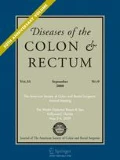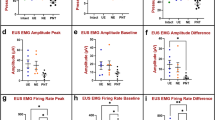Abstract
Purpose: This study was undertaken to document the effect of pudendal nerve function on anal incontinence after repair of rectal prolapse. METHODS: Patients with full rectal prolapse (n=24) were prospectively evaluated by anal manometry and pudendal nerve terminal motor latency (PNTML) before and after surgical correction of rectal prolapse (low anterior resection (LAR; n=13) and retrorectal sacral fixation (RSF; n=11)). RESULTS: Prolapse was corrected in all patients; there were no recurrences during a mean 25-month follow-up. Postoperative PNTML was prolonged bilaterally (>2.2 ms) in six patients (3 LAR; 3 RSF); five patients were incontinent (83 percent). PNTML was prolonged unilaterally in eight patients (4 LAR; 4 RSF); three patients were incontinent (38 percent). PNTML was normal in five patients (3 LAR; 2 RSF); one was incontinent (20 percent). Postoperative squeeze pressures were significantly higher for patients with normal PNTML than for those with bilateral abnormal PNTML (145 vs.66.5 mmHg; P =0.0151). Patients with unilateral abnormal PNTML had higher postoperative squeeze pressures than those with bilateral abnormal PNTML, but the difference was not significant (94.8 vs.66.5 mmHg; P=0.3182). The surgical procedure did not affect postoperative sphincter function or PNTML. CONCLUSION: Injury to the pudendal nerve contributes to postoperative incontinence after repair of rectal prolapse. Status of anal continence after surgical correction of rectal prolapse can be predicted by postoperative measurement of PNTML.
Similar content being viewed by others
References
Williams JG, Wong WD, Jensen L, Rothenberger DA, Goldberg SM. Incontinence and rectal prolapse: a prospective, manometric study. Dis Colon Rectum 1991;34: 209–16.
Broden G, Kolk A, Holmstrom B. Recovery of the internal anal sphincter following rectopexy: a possible explanation for continence improvement. Int J Colorectal Dis 1988;3:23–8.
Luukkonen P, Mikkonen U, Jarvinen H. Abdominal rectopexy with sigmoidectomy vs rectopexy alone for rectal prolapse: a prospective randomized study. Int J Colorectal Dis 1992;7:219–22.
Kuijpers JH, De Morree H. Toward a selection of the most appropriate procedure in the treatment of complete rectal prolapse. Dis Colon Rectum 1988;31:355–7.
Sayfan J, Pinho M, Alexander-Williams J, Keighley MR. Sutured posterior abdominal rectopexy with sigmoidectomy compared with Marlex rectopexy for rectal prolapse. Br J Surg 1990;77:143–5.
Speakman CT, Madden MV, Nicholls RJ, Kamm MA. Lateral ligament division during rectopexy causes constipation but prevents recurrence: results of a prospective randomized study. Br J Surg 1991;78:1431–3.
Sainio AP, Voutilainen PE, Husa AI. Recovery of anal sphincter function following transabdominal repair of rectal prolapse: cause of improved continence? Dis Colon Rectum 1991;34:816–21.
Yoshioka K, Hyland G, Keighley MR. Anorectal function after abdominal rectopexy: parameters of predictive value in identifying return of continence. Br J Surg 1989;76:64–8.
Matheson DM, Keighley MR. Manometric evaluation of rectal prolapse and faecal incontinence. Gut 1981;22:126–9.
Metcalf AM, Leoning-Baucke V. Anorectal function and defecation dynamics in patients with rectal prolapse. Am J Surg 1988;155:206–10.
Vongsangnak V, Varma JS, Watters D, Smith AN. Clinical, manometric and surgical aspects of complete prolapse of the rectum. J R Coll Surg Edinb 1985;30:251–4.
Farouk R, Duthie GS, Bartolo DC, MacGregor AB. Restoration of continence following rectopexy for rectal prolapse and recovery of the internal anal sphincter electromyogram. Br J Surg 1992;79:439–40.
Hiltunen KM, Matikainen M. Improvement of continence after abdominal rectopexy for rectal prolapse. Int J Colorectal Dis 1992;7:8–10.
Freckner B, Euler OV. Influence of pudendal block on the function of the anal sphincters. Gut 1975;16:482–9.
Yoshioka K, Keighley MR. Parameters which will identify patients who are likely to remain incontinent after abdominal rectopexy [abstract]. Br J Surg 1989;76:637.
Parks AG, Swash M, Urich H. Sphincter denervation in anorectal incontinence and rectal prolapse. Gut 1977;18:656–65.
Percy JP, Swash M, Neill ME, Parks AG. Electrophysio-logical study of motor nerve supply of pelvic floor. Lancet 1980;1:16–7.
Snooks SJ, Henry MM, Swash M. Anorectal incontinence and rectal prolapse: differential assessment of the innervation to puborectalis and external anal sphincter muscles. Gut 1985;25:470–6.
Kiff ES, Swash M. Normal proximal and delayed distal conduction in the pudendal nerves of patients with idiopathic neurogenic faecal incontinence. J Neurol Neurosurg Psychiatry 1984;47:820–3.
Neill ME, Parks AG, Swash M. Physiological studies of the anal sphincter musculature in faecal incontinence and rectal prolapse. Br J Surg 1981;68:531–6.
Author information
Authors and Affiliations
Additional information
Read at the meeting of The American Society of Colon and Rectal Surgeons, Seattle, Washington, June 9 to 14, 1996.
About this article
Cite this article
Birnbaum, E.H., Stamm, L., Rafferty, J.F. et al. Pudendal nerve terminal motor latency influences surgical outcome in treatment of rectal prolapse. Dis Colon Rectum 39, 1215–1221 (1996). https://doi.org/10.1007/BF02055111
Issue Date:
DOI: https://doi.org/10.1007/BF02055111



